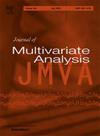Estimators for multivariate allometric regression model
IF 1.4
3区 数学
Q2 STATISTICS & PROBABILITY
引用次数: 0
Abstract
In a regression model with multiple response variables and multiple explanatory variables, if the difference of the mean vectors of the response variables for different values of explanatory variables is always in the direction of the first principal eigenvector of the covariance matrix of the response variables, then it is called a multivariate allometric regression model. This paper studies the estimation of the first principal eigenvector in the multivariate allometric regression model. A class of estimators that includes conventional estimators is proposed based on weighted sum-of-squares matrices of regression sum-of-squares matrix and residual sum-of-squares matrix. We establish an upper bound of the mean squared error of the estimators contained in this class, and the weight value minimizing the upper bound is derived. Sufficient conditions for the consistency of the estimators are discussed in weak identifiability regimes under which the difference of the largest and second largest eigenvalues of the covariance matrix decays asymptotically and in “large , large ” regimes, where is the number of response variables and is the sample size. Several numerical results are also presented.
多元异速回归模型的估计量
在多响应变量和多解释变量的回归模型中,如果不同解释变量值下的响应变量均值向量之差始终在响应变量协方差矩阵第一主特征向量的方向上,则称为多元异速回归模型。研究了多元异速回归模型中第一主特征向量的估计。提出了一类包含传统估计量的基于加权平方和矩阵的回归平方和矩阵和残差平方和矩阵的估计量。我们建立了该类估计量的均方误差的上界,并导出了使上界最小的权值。在协方差矩阵的第一大特征值和第二大特征值之差渐近衰减的弱可辨识域和p为响应变量数,n为样本量的“大p,大n”域,讨论了估计量相合的充分条件。给出了几个数值结果。
本文章由计算机程序翻译,如有差异,请以英文原文为准。
求助全文
约1分钟内获得全文
求助全文
来源期刊

Journal of Multivariate Analysis
数学-统计学与概率论
CiteScore
2.40
自引率
25.00%
发文量
108
审稿时长
74 days
期刊介绍:
Founded in 1971, the Journal of Multivariate Analysis (JMVA) is the central venue for the publication of new, relevant methodology and particularly innovative applications pertaining to the analysis and interpretation of multidimensional data.
The journal welcomes contributions to all aspects of multivariate data analysis and modeling, including cluster analysis, discriminant analysis, factor analysis, and multidimensional continuous or discrete distribution theory. Topics of current interest include, but are not limited to, inferential aspects of
Copula modeling
Functional data analysis
Graphical modeling
High-dimensional data analysis
Image analysis
Multivariate extreme-value theory
Sparse modeling
Spatial statistics.
 求助内容:
求助内容: 应助结果提醒方式:
应助结果提醒方式:


